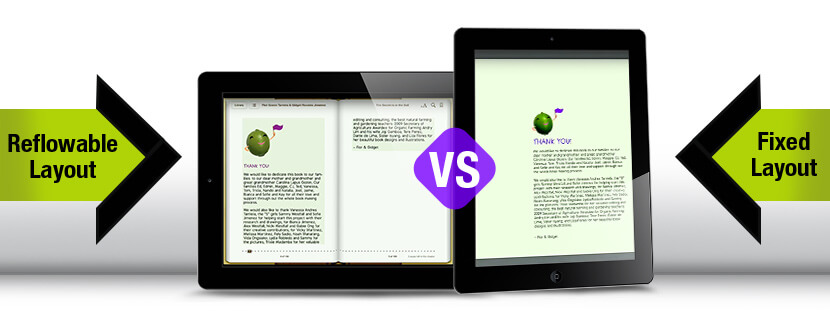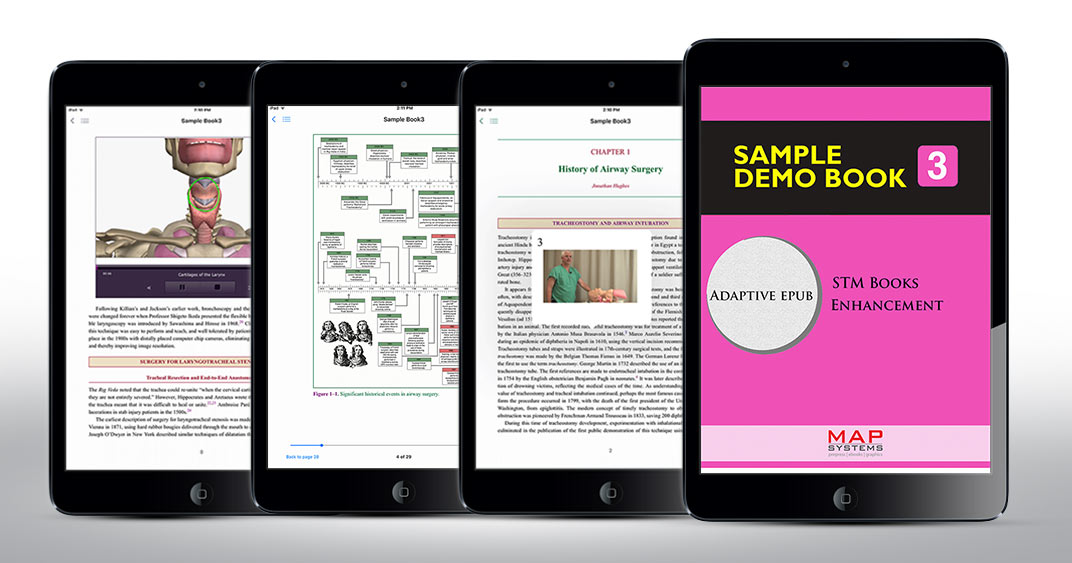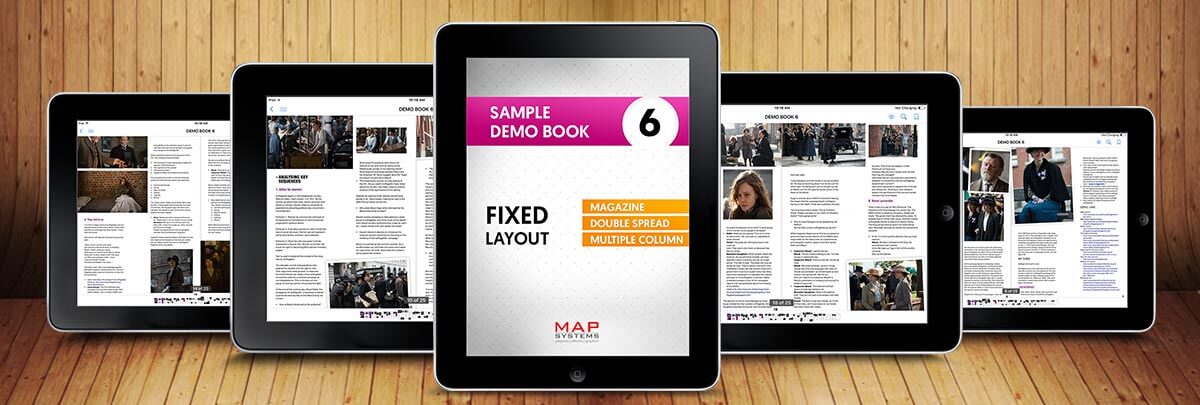Reflowable vs. fixed layout epub format comparison if done in a critical manner can help you to find some key differences. A king part of eBooks arrive in standard or reflowable format. Among many, the basic .ePub as well as .mobi files dominate the current eBook domain.
This form avails readers with enough control. They can determines the way in which the text is displayed in regard of font type, size and colour etc. This form is ideal when the eBook includes mainly text. Even when there are images, if they are placed after or before the text, reflowable eBook formats are ideal. Reflowable format is in fact accepted almost everywhere as they are compatible on virtually every eBook reader.
Now if you are wondering which format would suit your requirement the best, the very first step you should initiate is to carry out a detailed self-analysis. Generally, standard format is recommended, but not always. It is ideal when you have restricted budget but still want to get wider distribution and reach. You will have few options to choose from. Either you can allow stylistic adjustments for using the standard ePub, use fixed layout format or else a blend of both. Your choice can be driven by several factors such as the source files, the genre and budget etc.

Reflowable epub format (Standard layout)
Able to provide responsive images and text, reflowable layout is a robust format offering better rendering capabilities. The positioning and the look of the images and text on the page is dependent on the following aspects such as;
- The dimensions of the screen (desktop, tablet or mobile)
- The orientation of the screen (landscape or portrait)
- The changes that have been made to the size of the text

When it comes to publishing, reflowable format is the best and most reliable eBook format. It is the capability of reflowable eBook formats to arrange the texts and images on an eBook as flowing elements and then render the same on the screens of the devices being used to render them accordingly. It is also capable of arranging the texts and images when the orientation of the screen is changed from landscape to portrait or vice versa for optimum readability. The format also makes it possible for the readers to effectively change the size of the text improving the readability further even for readers with slight visual impairments.
When reflowable eBook formats are used, it is able to render the content on the screen all by itself requiring the process more cognitively less demanding. There is no need for the reader to do anything else apart from doing it vertically making the whole affair just natural as turning the pages of a real book while reading a book.
In an eBook that makes use of the reflowable eBook formats, the number of pages is dynamic as it changes depending upon the dimension of the screens where it is rendered. The bigger the screen size, smaller would be the number of pages.
It has become the industry standard that most of the single column and text-heavy eBooks are best to be used in the reflowable format that makes it end in the eBook readers as either in the form of EPUB or Mobi. If you have noticed, most of the books in the non-fiction and fiction genre end up having reflowable layout through intelligent and efficient reflowable ePub conversion.
Advantages
- It is easier, cheaper and quicker to produce eBooks in reflowable layout
- Having this format tend to have smaller size & hence retailers are likely to charge no charges for downloading.
- Most of the distributors accept reflowable eBooks
- Irrespective of the size and type of the eBook readers, these tend to render pretty well on most
- It is possible to enlarge even the texts on the page, giving the reader enhanced readability for the users even on devices with smaller screen without compromising on any of the original formatting capabilities
Disadvantages
- It can only be used for eBooks having single-column, text-heavy content
- Embedded formats are hardly ever supported
- Publishers and authors have no to little control over the way their texts and images are being rendered on the devices, sometimes making it hard for them to use this format for design-heavy eBooks
Fixed layout epub format
Just the way a PDF works, fixed layout format is thought as a creative digital lock to hold the texts and images on the eBook without altering the position of the same, wherever it is rendered. This format becomes extremely important and robust for eBooks that rely heavily on illustrations and images that must go accordingly with certain texts—such as children’s books, comic book and magazines. Publishers rely greatly on this format when they need to publish books such as cookbooks and coffee table and recipe books, etc. For this type of publishing, fixed layout commands exceptional importance in digital formatting process.

Fixed layout format becomes extremely important when you have overlaying interactive elements over each other. For example, if you are creating an eBook for children to help them learn the sounds of animals in a barn fixed layout is the got-to-format. You can have the illustration of a barn with different images of several animals in it. You can further embed the sounds of the animals to these images that can play the sounds upon being touched. For this to work the way you intend the positions of the various elements must stay where you intend them to be; not changing according to the screen size of the devices where it is rendered.
This format is the best for books that have various interactive content and graphic-heavy illustrations such as for multi-touch books, manga, cookbooks, graphic novels and travel guides etc.
Though it was not enthusiastically received by the publishing industry, fixed layout ePub using InDesign has been on the rise giving it the rightful position it must hold in the eBook industry as more people now prefer to read the digital counterparts of printed books.
What this means for the authors and designers is that they get more control over decision making with respect to how the text appears on a page, where the lines must start and end. Also, they can decide upon best the position of the text depending upon other multimedia elements on the page by intelligently adhering to fixed layout eBook guidelines. When it comes to fixed layout, the designers of the author has absolute control over how a page and its elements are rendered on the device irrespective of the size or orientation of the same.
Advantages
- When it comes to fixed layout eBooks, the control on how various content elements are rendered on a screen vests absolutely with the author and designer
- If the text that you want to render has multi-columns and has specific location at certain points, this is the best
- It is the best format for books such as cookbooks & graphic novels where the design of the same is a vital element
Disadvantages
- It may not be the best format for the users as they do not have any control over the font, margins, spacing or the size of the text.
- Not all the eBook readers of distributor chains support this format. Some of the retails do not even accept the format and hence your reach may be restricted.
- It tends to have large file size and it may attract additional download charges on sites such as Amazon.
- It is also not easy to produce, format and bring updates and is expensive to produce.
While trying to export in fixed format, chances are you will end up with an eBook in formats such as EPUB3; Kindle textbook creator and KF8 and PagePerfect and NOOK Kids.
It provides you with a myriad of options when making use of an array of background images, full-bleed graphics, and double-page spreads with multi-column text and vertical texts. Depending upon the capabilities of the eReader that is used, the format also provides avenues that can make use of embedded font, as well.
However, there is one thing to be had in mind while talking about fixed layout. It is always best rendered on larger screens that can easily display all the elements on a page in all its glory. And, it is fairly exasperating when rendered on devices with smaller screens. For famous graphic novels such as ‘V for Vendetta’ where the graphical representation is a key aspect to its narrative style, there cannot be a format that is best befitting as fixed layout.
In a nutshell, eBooks made in fixed layout formats have a layout, usually predefined by the author. This means, regardless of anything, the predetermined layout for each page will not change from its original shape. On the contrary, reflowable layouts are more flexible. Reflowable eBooks precisely adapt to the screen size and orientation of the device they are read on by the readers.
Conclusion
This article can be used as a means to answer a few questions as given below while trying to figure which format is conducive for you.
- The type of the eBook being created; is it a picture-heavy and interactive book or a text- heavy book?
- Does the book use a single-column text layout or a more complex one?
- Do the images and graphic elements perform as a complementary aspect of the text?
- The people you are trying to target as your audience?
Now, you have understood everything that you need to know while trying to figure out the format that you must be using to create an eBook in every way that you have intended it to be fixed layout conversion or reflowable ebook conversion. By weighing reflowable vs. fixed layout ePub advantages effectively, you will be able to use the layout that fits your eBook correctly.
You can now go ahead and make intelligent decisions that can make your eBooks all the better to provide impeccable user-experience.
